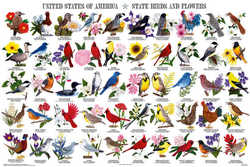
Oklahoma Symbols
Oklahoma State Game Bird
Wild Turkey

(Meleagris gallopavo)
Adopted on January 30, 1990.
The wild turkey, (Mileagris gallopavo,) is a large North American bird with brownish plumage and a bare wattled head and neck. Ancestor to America's common domesticated turkey. Adopted as Oklahoma game bird on January 30, 1990.
A true native American, the eastern wild turkey (Meleagris gallopavo silvestris) is the largest and most widely distributed of the six recognized subspecies of wild turkey in North America.
Wild turkeys live throughout Oklahoma and nest under bushes and logs. They eat insects, berries, and acorns, and occasionally they will feed on crops. They have shiny copper-colored feathers and brown and black tail feathers with cream-colored tips, heads are bald with blue skin and red or purple wattles. Male turkeys have tufts called "beards" in the middle of their chests.
Did you know that: The Wild Turkey has been proclaimed the official state game bird in each of the following states
Alabama | Massachusetts | Oklahoma | South Carolina
Oklahoma State Game Bird: Wild Turkey

There are only two species of Turkeys extant in the world today; the Wild Turkey of North America, and the Ocellated Turkey, (Meleagris ocellata,) of the Yucatan Peninsula, Mexico. From the fossil record they were once much more widespread. They diverged from pheasants 11 million years ago and were likely "distributed continuously from middle latitudes of North America to northern South America during the Pleistocene" (Porter 1994). Today the Wild Turkey exists as a native only in eastern and southwestern North America and northernmost Mexico; populations on the West Coast and in the Great Basin are introduced. However, since turkeys were once native to all these latter areas, it can be argued they are "re-introduced into a former range" rather than the despised plantings of non-native game birds which has so often occurred.
Bird Facts: Turkey Facts
- Turkeys are large birds, related to pheasants. Wild turkeys are native to wooded areas of North America.
- Male turkeys are called toms. Female turkeys are called hens.
- Only male turkeys make gobbling sounds.
- Wild turkeys can run and are good fliers. Domesticated turkeys cannot fly.
Characteristics of the Wild Turkey
The wild turkey is one of the largest birds in North America. An adult male can grow up to 4 feet long from his beak to his tail. Males have a dark, iridescent body. The flight feathers are black with brown stripes and are barred with white. the turkey has red wattles, a caruncle, and a blackish breast tuft. The wattle comprises the fleshy lobes hanging down from the chin or throat. The caruncle is the wart-like projections of the skin attached to the upper part of the forehead. The legs are spurred and spurs can grow as long as 3.175 centimeters. The leg scales are pink, pinkish gray, or silver gray. The head of the adult gobbler (male) is red, blue, or white depending on the bird's emotional status and on the season. Female turkeys are smaller and duller than males, and lack a breast tuft. Females also have a grayish head and the back of the neck is feathered.
Food Habits
Preferred habitats include mature forests, open woodlands, and farm areas. During the non-breeding season, the birds forage in flocks on the ground for acorns, seeds, some leaves, salamanders, worms, snails, and insects. Food items are swallowed whole and ground up in the bird's gizzard.
Reproduction
Males perform courtship displays by strutting and gobbling. During the spring, males will fan out their tails, strut and gobble in an attempt to attract and hold a harem of females. The call of the male Wild Turkey (also called a gobble) can be heard a 1.61 kilometers away. The Wild Turkey is polygamous, therefore one male will attempt to mate with several females. Eggs are laid two to three weeks after copulation. The hen usually nests on the ground in a depression, and the nest is usually surrounded by dense brush, vines, tangles, deep grass, or fallen tree tops. The nest contains 8-15 eggs. The incubation period is 28 days.
Behavior
By day the turkey can be seen grazing in fields and woodlands. At night wild turkeys roosts in trees. The wild turkey is a very wary bird with keen eyesight and hearing. In spite of its large size and rather awkward appearance, the wild turkey is a powerful flier, reaching speeds of up to 55 mph over short distances. Turkeys will most often fly hard and fast up through the treetops, then set their wings and glide back to the ground. In the fall, M. gallopavo flock with several males accompanying several females. There is no calling (unless the flock gets broken up) and there are no displays similar to those seen in the spring. The main objective is to gather enough fat reserves for the winter.
Habitat
Habitats preferred by Wild Turkeys include mixed coniferous and deciduous forests. Agricultural fields, orchards, and seasonal marshes are also locations favored by M. gallopavo.
Oklahoma Statutes
The law designating the Oklahoma state game bird is Section 25-98.13 (State game bird) of the Oklahoma Statutes, Title 25 (Definitions and General Provisions) Chapter 3 (State Emblems and Honorary Positions) Section 25-98.13.
Title 25. Definitions and General Provisions.
Chapter 3 - State Emblems and Honorary Positions.
§25-98.13. State game bird.
The wild turkey Meleagris gallopavo is hereby designated and adopted as the state game bird of the State of Oklahoma.
Added by Laws 2006, c. 232, § 1, emerg. eff. June 6, 2006.
Taxonomic Hierarchy: Wild Turkey
Kingdom: Animalia (animal)
Phylum: Chordata (chordates)
Class: Aves - Aves (birds)
Order: Galliformes (fowls)
Family: Phasianidae - Partridges, Turkeys, Grouse, Pheasants, Quail, cailles, faisans
Subfamily: Meleagridinae - Turkeys
Genus: Meleagris Linnaeus, 1758 - Turkeys
Species: Meleagris gallopavo Linnaeus, 1758 - Guajolote norteno, Wild Turkey, dindon sauvage
Taxonomic Serial No.: 176135







